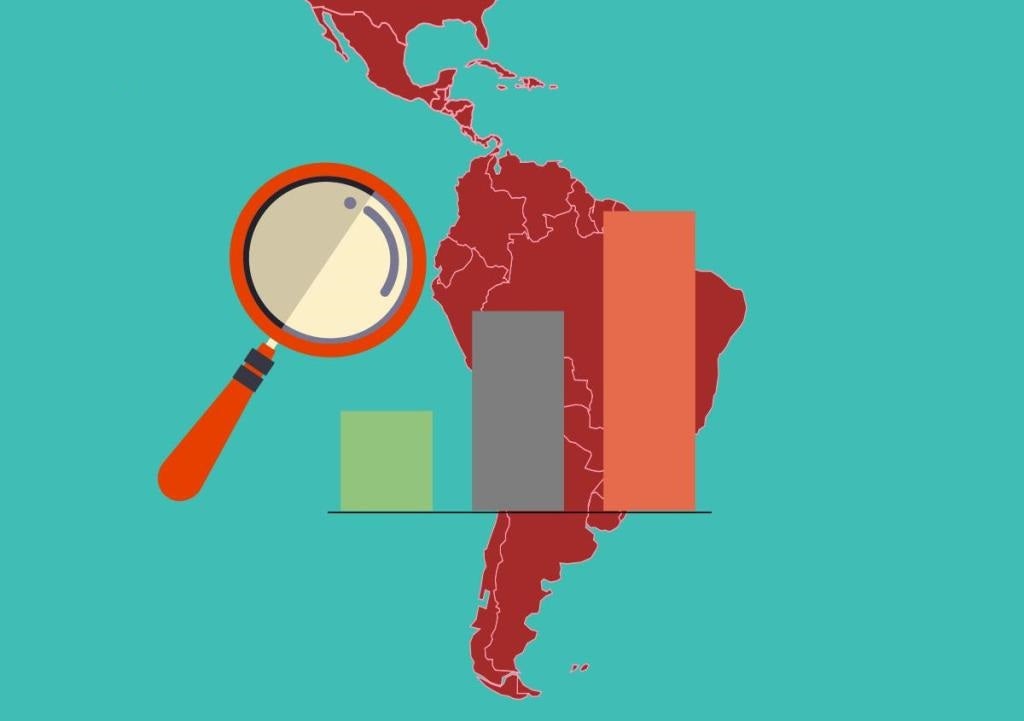As we mentioned in previous blogposts, there are many ways to interact with the new Inter-American Development Bank Open Data Portal, “Numbers for Development”. The portal allows you to explore, visualize and reuse over 1700 multi-sectorial indicators from 26 countries in the region collected by the Bank over more than 50 years.
The following blogpost includes a step by step guide to get five quick overviews of key development indicators for a given country in Latin America and the Caribbean.
Access the Countries at a Glance feature
Click here to visit “Numbers for Development” or access the IDB website and click on the “Data” tab at the top of the page. To begin, just select the country of interest in the “Countries at a Glance” Banner in the homepage of the portal.
1 Compare a country with the Regional Average
Once you have selected a country, you will access the “At a Glance” option which allows you to quickly compare the values of eleven important development indicators of a country with the regional average. If you mouse over the circle, you will get the exact value for that indicator. For example, below is the visualization that you get in the case of Brazil.
The indicators available in this section are:
- Macroeconomic Profile and Global Integration
- Credit to the Private Sector: % of GDP, end of period
- Openness (Exports+Imports as a share of GDP)
- Share of Primary Products in Exports
- Total Public Debt: % of GDP, end of period
- GDP: constant prices, cumulative growth last ten years, %
- Social Outlook
- % Labor Force Female
- % Unemployment Rate, Female (15-64)
- % Middle Class People
- % completing secondary school, 18-64 years old
- % Poverty, less than $2.5/day
- GNI Coefficient of Per Capita Household Income
2 Get a Macroeconomic Profile of Country
From the Countries at a Glance homepage, you also have the option to dig into the macroeconomic indicators of a country in the region. The Macroeconomic profile shows the values of five top macroeconomic indicators by graphing the trend of recent years. The indicators included are:
- CPI: Annual Average Inflation, %
- Current Account Balance: % of GDP
- GDP: Real Index Year on Year Growth, %
- Overall Fiscal Balance: % of GDP
- Total Exports (BOP): % of GDP
Following the Brazil example, the macroeconomic profile appears as follows:
3 Get the Social Outlook of a Country
The Social Outlook allows you to explore six social indicators by income quintiles through a tree map. Clicking on a different color in the map will graph the trend for that indicator. The six social indicators* include:
- % of households with access to improved sanitation facilities
- % of Labor Force Female
- % of salaried employees affiliated with the social security system
- % of households with access to piped water
- % of people aged 65 or older who receive a retirement pension
- Unemployment Rate
*For additional social indicators including % completing secondary school (18-64 years old) and % Middle Class People, use the “At a Glance” feature referred to in point 1 and the “Data” section explained in point 5.
The general tree map in the case of Brazil appears as follows:
If you zoom the tree map in one of the trends, such as “Labor Force Female” you’ll get the following type of visualization:
In both the view on the left and the view on the right, you can mouse over the rectangle or column to see the indicator name and value. To return to the original view, just click anywhere on the tree map and you can select a different indicator.
4 Understand the global integration of a country
The Global Integration section of Countries at a Glance includes a breakdown of the type of exports by country over the last 5 years. The types of products exported are:
- Primary Products
- Resource Based Manufactures
- Low Technology Manufactures
- Medium Technology Manufactures
- High Technology Manufactures
- Other Transactions
In this visualization, the left column shows the breakdown of product type by year and the half-moon on the right shows the summary of exports by type for all years. You can mouse over to see the values and isolate one of the variables. In the case of Brazil, the visualization appears as follows.
5 Get the country’s data
Do you want to see all of the Macroeconomic, Social, and Global Integration indicators in Countries at a Glance for a given country for available years in one place? Then visit the Data section. Not only can you view and download all of the Countries a Glance data for your country of choice from the Data section, there are five additional key macroeconomic indicators:
- Credit to the Private Sector: % of GDP, end of period
- Domestic Public Debt: % of GDP, end of period
- Gross Fixed Capital Formation: % of GDP
- Revenues: % of GDP
- Total Public Debt: % of GDP, end of period
Was there an indicator or visualization that caught your attention? Let us know in the comment section below.
By Alyson Williams, of the Felipe Herrera Library at the Inter-American Development Bank (IDB)
This is the fourth blogpost in a series of tutorials on the “Numbers for Development” portal









I love the Global Integration viz. It provides an interesting view of trend by export type over year. It is the only visualization type I’ve never tried and I’d love to learn how to create one myself. Any recommendations?